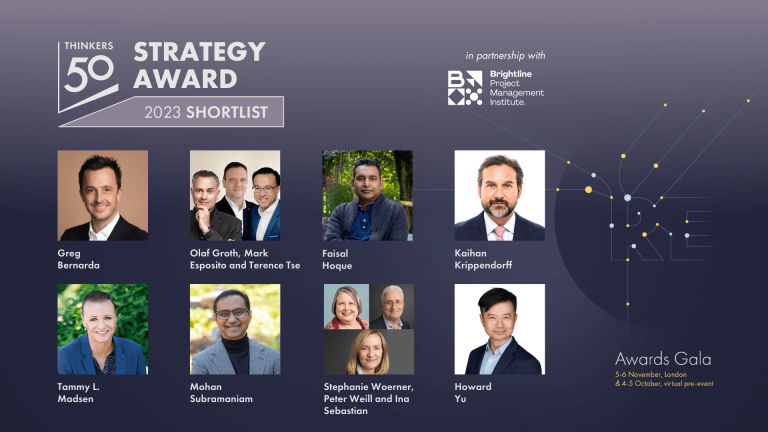

 “It struck me that if you look at strategy as an intellectual construct, a framework, a set of ideas, it really didn’t exist in a formal way much before the 1960s,” observes Walter Kiechel in The Lords of Strategy: The Secret History of the New Corporate World.
“It struck me that if you look at strategy as an intellectual construct, a framework, a set of ideas, it really didn’t exist in a formal way much before the 1960s,” observes Walter Kiechel in The Lords of Strategy: The Secret History of the New Corporate World.
Until the 1960s, models were the impenetrable domain of economists. The man who can be largely credited with bringing business models into the mainstream was Bruce Henderson (1915-92). Henderson was an engineer who worked as a strategic planner for General Electric. He was also dismissive of economists – “Darwin is probably a better guide to business competition than economists are,” said Henderson. From GE, he joined the management consultancy, Arthur D Little. In 1963, Henderson announced that he was leaving to set up his own consultancy, the Boston Consulting Group (BCG).
At the time, management consulting was beginning to establish itself as a profession and BCG is regarded by some as the first pure strategy consultancy. While strategy drifts in and out of fashion, it is a cause which BCG still robustly champions. “Strategy leads to the continuous creation of real value. Real value requires sustained competitive advantage. Leaping at opportunities without strategy consistently produces failure,” it says. BCG quickly became a great success. Within five years it was in the top group of consulting firms — where it has largely remained. It has been called “the most idea driven major consultancy in the world”.
The first model discovered — or re-discovered in this case — by Henderson was something of an antique. In the 1920s, an obscure company called Curtiss Aircraft came up with the concept of the ‘learning curve’, which also became known as the ‘experience curve’. This posited that unit costs declined as cumulative production increased because of the acquisition of experience. This had been applied solely to manufacturing. Henderson applied it to strategy rather than production and found that it still worked and provided a useful practical tool.
BCG went on to originate or develop concepts such as sustainable growth; time-based competition; Segment-of-One marketing; value-based strategy; total shareholder value; and, even, disease management. However, the model for which Henderson and BCG are best known is the Boston Matrix which measures market growth and relative market share for all the businesses in a particular firm. The hypothesis of the Boston Matrix is that companies with higher market share in faster growing industries are more profitable. The further to the left a business is on the Boston Matrix, the stronger a company should be.
As with most such models, refinements have been added along the way. On its original matrix, BCG superimposed a theory of cash management which included a hierarchy of uses of cash, numbered from one to four in their order of priority. This identified the top priority as cash cows, characterized by high market share and low growth. Investment in cash cows is easily justified as they are dull, safe and highly profitable. Next in line are the stars (high growth; high market share) though their investment requirements are likely to be significant. More problematic is the third category, question marks (or wildcats in some versions) where there is high growth and low share. Any investment in them is risky. The final category is the aptly titled, dogs, where low market share is allied to low growth. Dogs should not be approached.
Bruce Henderson was something of a legend as an employer. One of his recruits was Peter Lampl, now Sir Peter, founder of the Sutton Trust. “When I joined BCG, it was the best management consulting firm in the world. I was the first person to join BCG in Boston directly from a European business school. And I was treated like dirt! It had a total free market system. So, I arrived at BCG in 1973. I didn’t know anyone. They said, there’s your desk. And I said, well, what do I do? I was told that I had to find work, I had to talk to managers and vice-presidents and get them to employ me. I had a pretty tough start,” Lampl told us.
“The whole measure of performance at BCG was billability – how many hours you bill clients each week. That’s all that mattered. Bruce Henderson had a chart up in the office where everyone’s monthly billability was listed, as well as their moving annual billability, so you could see every month how everybody was doing. If people were declining in billability, they would disappear. All of a sudden, they wouldn’t show up. There was a huge churn rate, a half-life of about two and a half years. Bruce believed in survival of the fittest. It was crazy, but unbelievably exciting. At that time BCG was leading the pack. We were developing portfolio strategy, the experience curve and so on. We had some wonderful assignments.”
Celebrated in the 1960s, the Boston Matrix proved a highly popular innovation. From a business point of view, the Matrix had the characteristics of any great model: it was accessible, simple and useful. However, it was also limiting. Measuring corporate performance against two parameters is straightforward, but potentially dangerous if these are the only two parameters against which performance is measured. A creature of its times, the Matrix offered a blinkered view of a world where growth and profitability were all.
The Boston Matrix encouraged a preoccupation with market share. This was not to the liking of all executives. In a 1974 speech, David Packard warned Hewlett-Packard staff: “If I hear anybody talking about how big their share of the market is or what they’re trying to do to increase their share of the market, I’m going to personally see that a black mark gets put in their personnel folder.”
Not surprisingly, other consulting firms were quick to respond with their own variations on the Boston Matrix. The most credible response came in the form of the General Electric and McKinsey matrix. This measured performance against two variables – industry attractiveness and business strength – and was effectively a dandified version of the original.
As a business tool, the Boston Matrix had a significant and long-term impact. It provides a useful way of looking at the world. Of equal significance was its influence on the management consulting business. It spawned a host of imitators. Now, no consultant’s report is complete without a matrix of some sort. More importantly, BCG effectively introduced off-the-shelf consulting (though it wouldn’t see it that way). Companies required the company’s big idea. They wanted to see how they fared on the Matrix and how it could shape their strategies. The consulting firm product was born.
Previously consultants had gone in to client companies to solve specific business problems. The success of the Boston Matrix marked a change in tack. As well as problem solving, consultancy became concerned with passing on the latest ideas, the frameworks, models and matrices which were the height of fashion. Problem solvers became peddlers of big ideas. This opened up huge new vistas for the management consultancy profession which it has been assiduously – and profitably – chasing ever since.
Resources
Walter Kiechel, The Lords of Strategy, Harvard Business Press, 2010
This was originally published in What we mean when we talk about strategy by Stuart Crainer and Des Dearlove (Infinite Ideas, 2016).

Thinkers50 Limited
The Studio
Highfield Lane
Wargrave RG10 8PZ
United Kingdom

Thinkers50 Limited
The Studio
Highfield Lane
Wargrave RG10 8PZ
United Kingdom

| Cookie | Duration | Description |
|---|---|---|
| LANG | 9 hours | Linkedin set this cookie to set user's preferred language. |
| nsid | session | This cookie is set by the provider PayPal to enable the PayPal payment service in the website. |
| sp_landing | 1 day | The sp_landing is set by Spotify to implement audio content from Spotify on the website and also registers information on user interaction related to the audio content. |
| sp_t | 1 year | The sp_t cookie is set by Spotify to implement audio content from Spotify on the website and also registers information on user interaction related to the audio content. |
| tsrce | 3 days | PayPal sets this cookie to enable the PayPal payment service in the website. |
| x-pp-s | session | PayPal sets this cookie to process payments on the site. |
| __cf_bm | 30 minutes | This cookie, set by Cloudflare, is used to support Cloudflare Bot Management. |
| Cookie | Duration | Description |
|---|---|---|
| l7_az | 30 minutes | This cookie is necessary for the PayPal login-function on the website. |
| Cookie | Duration | Description |
|---|---|---|
| CONSENT | 2 years | YouTube sets this cookie via embedded youtube-videos and registers anonymous statistical data. |
| _ga | 2 years | The _ga cookie, installed by Google Analytics, calculates visitor, session and campaign data and also keeps track of site usage for the site's analytics report. The cookie stores information anonymously and assigns a randomly generated number to recognize unique visitors. |
| _gat_gtag_UA_10408481_1 | 1 minute | Set by Google to distinguish users. |
| _ga_ZP8HQ8RZXS | 2 years | This cookie is installed by Google Analytics. |
| _gid | 1 day | Installed by Google Analytics, _gid cookie stores information on how visitors use a website, while also creating an analytics report of the website's performance. Some of the data that are collected include the number of visitors, their source, and the pages they visit anonymously. |
| Cookie | Duration | Description |
|---|---|---|
| NID | 6 months | NID cookie, set by Google, is used for advertising purposes; to limit the number of times the user sees an ad, to mute unwanted ads, and to measure the effectiveness of ads. |
| test_cookie | 15 minutes | The test_cookie is set by doubleclick.net and is used to determine if the user's browser supports cookies. |
| VISITOR_INFO1_LIVE | 5 months 27 days | A cookie set by YouTube to measure bandwidth that determines whether the user gets the new or old player interface. |
| YSC | session | YSC cookie is set by Youtube and is used to track the views of embedded videos on Youtube pages. |
| yt-remote-connected-devices | never | YouTube sets this cookie to store the video preferences of the user using embedded YouTube video. |
| yt-remote-device-id | never | YouTube sets this cookie to store the video preferences of the user using embedded YouTube video. |
| yt.innertube::nextId | never | This cookie, set by YouTube, registers a unique ID to store data on what videos from YouTube the user has seen. |
| yt.innertube::requests | never | This cookie, set by YouTube, registers a unique ID to store data on what videos from YouTube the user has seen. |
| Cookie | Duration | Description |
|---|---|---|
| DEVICE_INFO | 5 months 27 days | No description |
| loglevel | never | No description available. |
| m | 2 years | No description available. |
Thinkers50 Limited has updated its Privacy Policy on 28 March 2024 with several amendments and additions to the previous version, to fully incorporate to the text information required by current applicable date protection regulation. Processing of the personal data of Thinkers50’s customers, potential customers and other stakeholders has not been changed essentially, but the texts have been clarified and amended to give more detailed information of the processing activities.